In the world of online business listings there exists different definitions of what is a ‘duplicate listing’. Internet marketing professionals may view listings in a different light than an internet yellow pages (IYP) venue or a data aggregator might. That is understandable, since we each have different reasons for working with the data contained in said listings.
Some people understand the importance of not having incorrect/duplicate business listings in existence, however it appears that some venues or business owners seem to think it is OK for a business to be listed more than once in a particular business directory.
Dumping the Dupes
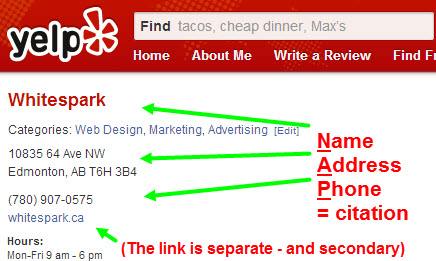
Example of a NAP Citation (by Whitespark)
A single business should have one listing in each IYP venue. According to SEO industry best practices, it is important that each listing contains the correct company name, address, and phone number (NAP) in each listing. In general, the more IYP listings you have and the more accurate, consistent, and complete those listings are, the better a company’s website has at ranking for local search queries versus a competitor, if all other ranking factors are equal.
In the Internet marketing industry, listings with 2 of 3 NAP components being the same would most likely be considered a duplicate listing that is in need of suppression, however, as mentioned earlier, not in everyone’s opinion.
Differing Definitions of ‘Duplicate’ Listings
This is the case with one of the 4 major business data aggregators, Acxiom, for example. When I wrote support, on behalf of a client, asking them to suppress a listing, they replied saying:
“The two listings you noted below are not actually duplicates per se, as they have different business names. Which is actually rather common for businesses ([as they may] prefer to actually list multiple times, with different business names). We are not permitted to remove them unless the business owner or an agent of the business owner were to claim the listings […] and verify ownership of the business.”
On a previous occasion, I wrote Acxiom support for the removal of a different duplicate listing since it was not showing up in the Moz Local duplicate closure dashboard for some reason. Acxiom support replied to me saying:
“It would not be considered a duplicate since it has a different phone number. Acxiom would treat those as two separate listings.”
So, it is now obvious that there are differences in opinion in the industry as to what, really, is a duplicate listing. It is possible, perhaps, that an IYP venue or aggregator does not really know if it two listings represent unique business or not, so maybe they err on the side of having more listings in their database than having a smaller, yet more correct database. Another simple explanation is that they consider a listing to be a ‘duplicate’ on when the name, the address and the phone number all match exactly (where all 3 of 3 NAP components are the same).
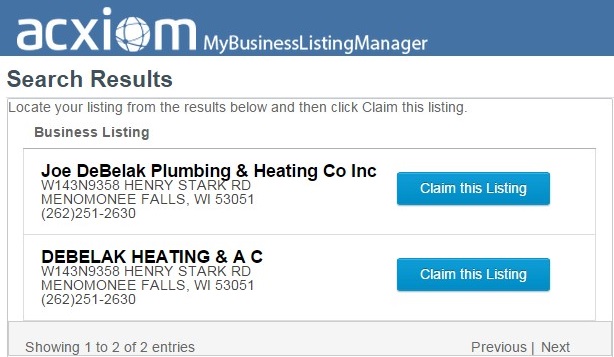
Example of a Duplicate Listing in the Major Aggregator Acxiom
I had once understood that Acxiom placed most emphasis on the phone number when considering a listing as unique or not, however now we know that having two similar, but different, names with the other 2 NAP components being equal is not considered a duplicate in their books. They also don’t consider listings having the exact same name and address, but unique phone numbers, to be duplicates. However, this may be due to the fact that, at one time, aggregators depended very heavily on a business’ phone number as a unique identifier for records in their database.
When claiming listings, manually, on Acxiom and updating them; if a business name or phone number is incorrect you must first ‘delete’ that listing and then create a new listing. That means that you need to claim the incorrect listing, then once verified by phone call, you request its removal from the database. Then you can create the new listing from scratch with the proper data. One the other hand, if the address was the only NAP component in need of correction, you can claim and update that same listing.
I reached out to Acxiom support to better understand this situation and they explained it to me saying:
“The business name and phone number cannot be changed on the listings. Once the listing is verified, you can delete this listing and add a new listing with the correct business name. […] Removing the incorrect listing ensures the listing will not populate our database again on the next update from our local teleco sources. Our automated processing uses logic matching business name and phone numbers. When you change the business name or phone number on the listing, you are creating an entirely different listing. When the next update comes in from our sources who still have the incorrect information, the incorrect listing can populate our database again. On the other hand, when the incorrect listing is deleted on our file, on the next update, the deletion will be recognized and the listing will not be added to our file again.”
Records Require Unique Identifiers & References to Bad Data
To expound upon this phenomenon, I reached out to Christian Ward, the Executive Vice President of Partnerships at Yext. He told me via email that: “Because [a] phone number is a very easy identifier, it still provides a crutch in many cases to aggregating data and conflating records. This is not ideal, but almost ‘the easy way out’.” He went on to say that aggregators have “moved to have their own unique ID, or GUID, in their database for every record.” However the fact is that “some [publishers] DO use phone as a primary key, or if they don’t, its the absolute dominant matching factor” in their conflation and aggregation process.
What Acxiom does with their process for the removal of listings with incorrect data is very much related to the concept that Christian Ward explains in his post called ‘Duplicate Suppression vs Deletion‘ in a thread on Linda Buquet’s ‘Local Search Forum’. He says that when you delete a record (completely) you then “remove the ability to track that deletion to prevent it from once again reappearing.” He goes on to say:
“When you ask an aggregator or publisher to delete a record, they typically lose the ability to prevent the primary source from re-creating a duplicate because they are not the primary source themselves.”
“Suppression […] is the solution at publishers and aggregators where a temporary table is created […] where the unique identifiers will be stored for any listing or data source that has been flagged as a duplicate. This allows for the aggregator or publisher to constantly compare new sources of data (or repeat sources of data) against both the database they publish to as well as the temporary table filled with all the rubbish that has been identified in the past.”
“Suppression allows us to actually be on the look out for error records on an ongoing basis; by contrast, deletion all but ensures data will sneak back in, re-creating duplicates with new unique record identifiers. This means we have to start all over from scratch: finding the duplicate, collating a list, submitting the list, and trying to remove them individually.”
New Terminology for Differentiating Duplicate Listings
Yext’s Christian Ward also coined the concept of referring to duplicates as ‘doppelganger’ listings. They may look the same in some ways, but are actually different). In a 2015 investigation, Yext found 40,607 doppelganger listings across 2,719 unique locations in 47 IYP venues. That equates to an average of 14.93 doppelgangers per location, which works out to an average of 3.15 duplicate listings per internet yellow page directory!
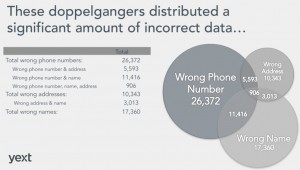
Variations of Business NAP Causes ‘Doppelganger’ Duplicate Listings – Yext
Here is a run down of the most common NAP errors found in his study:
N__ | 42.7% had an incorrect Name
_A_ | 25.5% had an incorrect Address
__P | 64.9% had an incorrect Phone Number
N_P | 28.1% had wrong Name & Phone Number
_AP | 13.8% had wrong Address & Phone Number
NA_ | 7.4% had wrong Name & Address
NAP | 2.2% had all NAP components wrong (something else is linking the records, somehow)
Christian mentions that there are many types of doppelgangers (aka ‘dopps’) and gave examples of 4 common varieties using real-life doppelgangers: the Will Ferrell, the Vladimir Putin, the Douglas MacArthur and the Miley Cyrus.
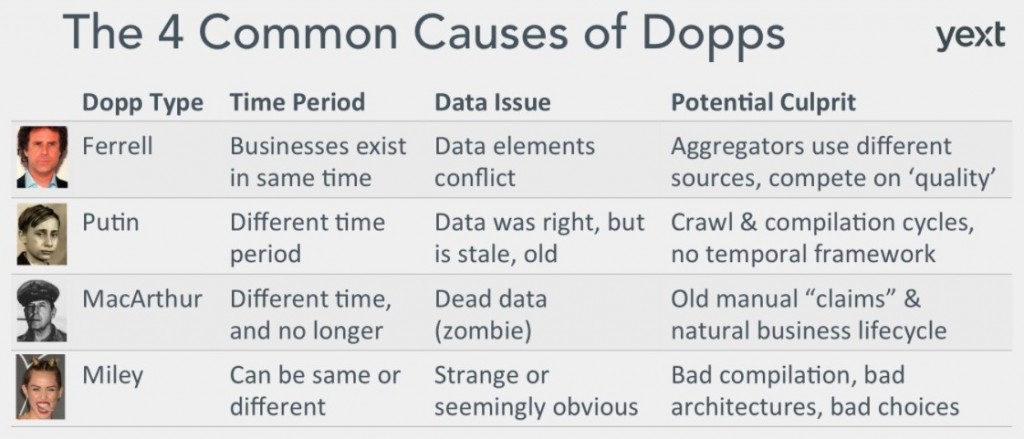
He explains the variations in the following manner:
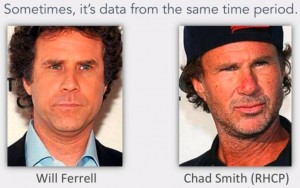 Will Ferrell (actor) vs Chad Smith (musician)
Will Ferrell (actor) vs Chad Smith (musician)
– businesses exist at same time, data elements conflict
– aggregators use different sources and compete on ‘quality’
– they want their files to be different, compilation and conflation processes vary
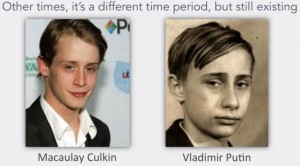 Macaulay Culkin (actor) vs. Vladimir Putin (President)
Macaulay Culkin (actor) vs. Vladimir Putin (President)
– different time period – data was right, but is stale or old data
– blame it on crawl and compilation cycles, no temporal framework
– data changes between cycles
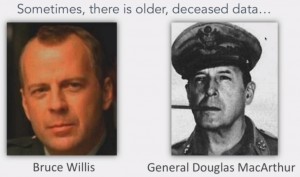 Bruce Willis (actor) vs Douglas MacArthur (General)
Bruce Willis (actor) vs Douglas MacArthur (General)
– dead data, out of business companies don’t close their listings
– Google may unverify businesses that don’t update their data in a while
– old manual ‘claims’ and natural business lifecycle
 Miley Cyrus (musician)
Miley Cyrus (musician)
– strange or seemingly obvious data issues – look the same on the surface, but have some connection to another record
– bad compilation, bad architecture, bad choices
– can be same or different time period
In light of what I mentioned earlier in this article, using this doppelganger term can really help to clarify the duplicate listing situation a little. (If you don’t want to admit that a listing is a duplicate, can you at least agree that it is a doppelganger?) 🙂 However, I just can’t bring myself to request the ‘suppression of a doppelganger listing’ yet when writing an IYP publisher or major aggregator tech support. 😛
As you can see, we need to be able to agree on what exactly ‘is’ a duplicate listing. Some people see a dupe differently. Does a duplicate listing only exist when they are exact replicas of each other? Should we call duplicate listings with minor variations ‘doppelgangers’, instead, then? Whether an online business listing is considered a ‘dupe’ or ‘dopp’, the goal should be the same; to eliminate them!
If you would like help cleaning up your the online presence of your business, let us know. Contact the Orion Group to get started with suppressing your duplicated business listing online! We will analyze your listings and let you know which NAP cleanup package we recommend for your situation.
